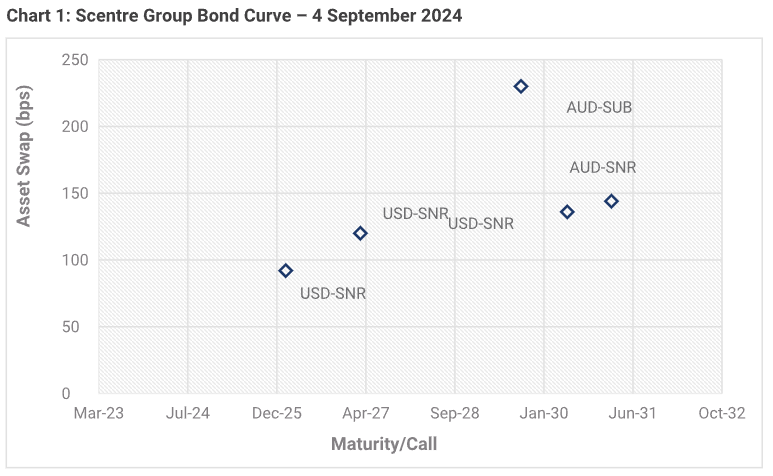A new era for tactical fixed income
The announcement came on the heels of a surge in interest in corporate hybrids sparked by the successful raising for Australian Securities Exchange (ASX) listed mall operator Scentre Group (ASX: SCG). Yarra’s outlook for Australia’s hybrid bond market—of which bank AT1 hybrids make up around $41 billion—considers these latest proposed regulatory changes while focusing on the future potential for hybrids in funding corporate Australia’s energy transition ambitions.
While uncertainty prevails in hybrid bank issuance for now, and short-term opportunities may arise, over the longer-term a broader set of dynamics is emerging for hybrids, particularly in sectors like energy and infrastructure.
Expanding role in Australia’s energy transition
The potential scale of the energy transition in Australia offers an exciting growth opportunity for corporate hybrids. As energy transition projects such as new transmission lines and large-scale generation get underway, hybrids can and should play a role in funding the significant upfront capital costs and become a permanent feature of issuer capital structures.
We estimate a total system investment of $400 billion is required by 2050 in order to decarbonise Australia’s energy market with a focus on new energy generation including investment in wind farms, solar, batteries, and associated transmission assets.
For large-scale energy transition projects, such as new transmission lines and renewable energy facilities, hybrids offer a way to fund significant upfront capital costs without putting undue strain on a company’s balance sheet.
The recent success of Scentre's corporate hybrid raising demonstrates this growing interest from non-financial corporates looking to leverage a flexible funding tool, and we expect this interest to grow from here with further non-financial corporate issuance likely in FY2025.
Bringing it back to fundamentals
We are forecasting a new era for tactical fixed income, characterised by sustained, higher yields. In this environment, investors, particularly those focused on investment-grade assets, are increasingly comfortable holding instruments such as hybrids, viewing the attractive yields on offer as ample compensation for assumed risk.
Further, with APRA’s decision to phase out AT1 hybrids, there is an expected shift of a substantial pool of capital, estimated to be around $41 billion, that will be seeking new investment avenues. This development is likely to create significant opportunities for corporate hybrids to emerge as a viable alternative for retail investors who are in search of yield. Consequently, we anticipate that corporate hybrid instruments could play a crucial role in filling the gap left by the diminishing bank hybrid market. This shift could potentially lead to a resurgence of hybrid issuance on the ASX, ensuring that investors continue to have access to the attractive yields they have grown accustomed to with bank hybrids, but now through corporate issuance by larger, investment-grade companies.
It is conceivable that banks may opt for increased Tier 2 issuance as a strategic move to maintain access to retail capital pools and fulfil their capital requirements while they gradually wind down their AT1 hybrid instruments. This strategic shift towards Tier 2 issuance could provide banks with the necessary flexibility to navigate the changing regulatory landscape and continue to meet their capital needs effectively.
Hybrids in portfolio construction
A key performance factor here is the issuer's credit strength—when dealing with investment-grade hybrids from strong issuers, the chance of conversion or extension is significantly diminished but investors still get rewarded for taking on what are essentially low-probability events.

With the potential to deliver equity-like returns in a fixed income framework, hybrids offer investors a balanced option within a portfolio. We also view the ‘higher for longer’ interest rate outlook as a factor to consider when assessing their role within a portfolio. When traditional bond yields are relatively low, hybrids can deliver a premium over other fixed income instruments without compromising credit quality.
Myths about hybrids
Provided you are investing in high-quality issuers the likelihood of hybrids not being refinanced at their call (redemption) dates or experiencing write-downs should be quite low.
This dynamic has made hybrids a popular choice among sophisticated fixed income investors seeking higher returns without assuming the full risk profile of equity.
An elegant solution for balancing capital needs and sustainability goals
Because of their ‘hybrid’ nature—whereby half of the amount on issuance is counted as equity and, therefore, not included in that gearing calculation—hybrids can be a great source of capital flexibility. This can mean the ability to run a little bit more debt, negate the need for asset sales, optimise the amount of equity capital, or support and protect a credit rating.
Scentre Group’s successful, high-profile bond issuance earlier this month placed hybrids and their investment features squarely back in the spotlight, signalling to investors the return of attractive investment-grade hybrids. Coupled with the regulatory changes that may usher in the end of traditional bank-issued hybrid securities like AT1’s, and it is safe to say this is a sector in flux with some eye-catching opportunities ahead.

3 topics
1 fund mentioned

